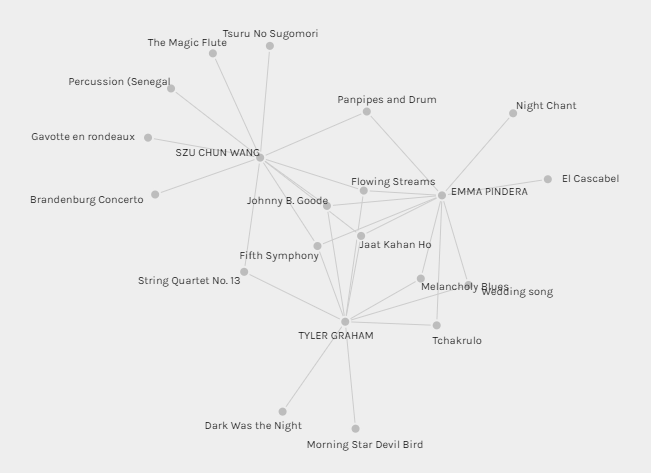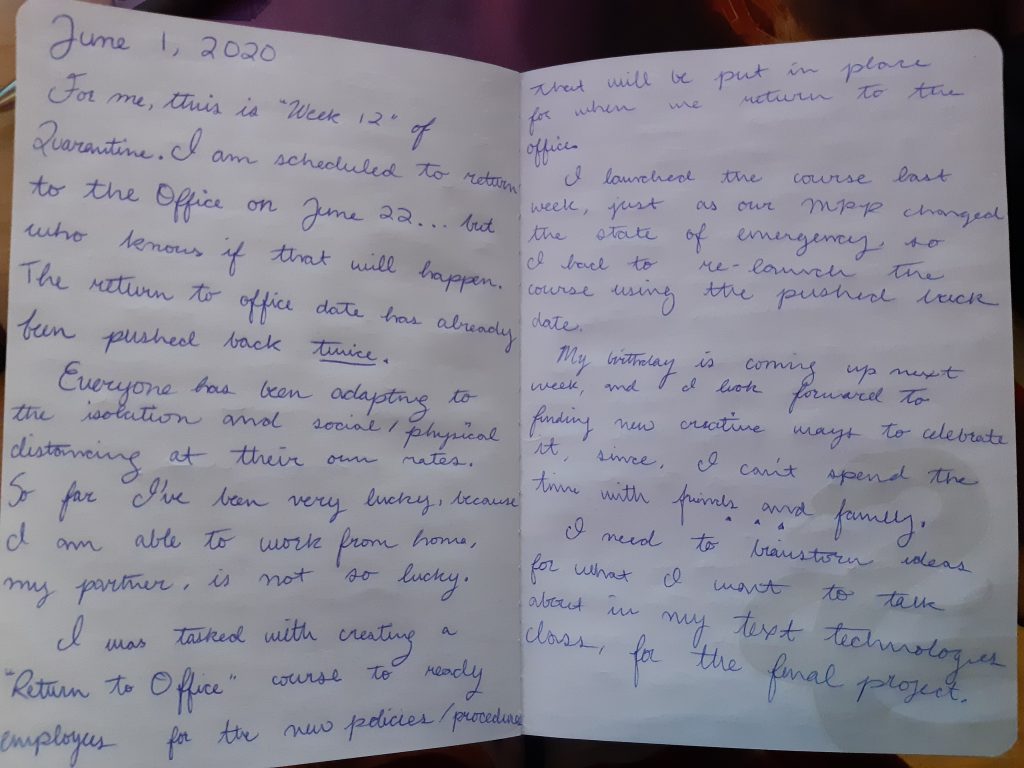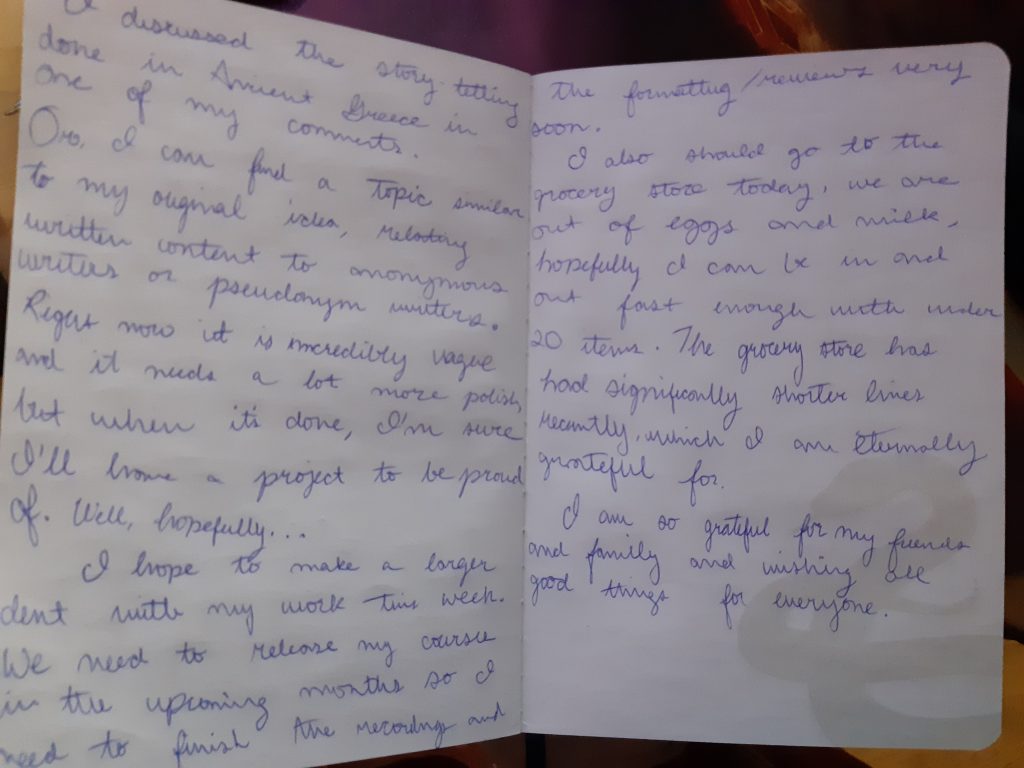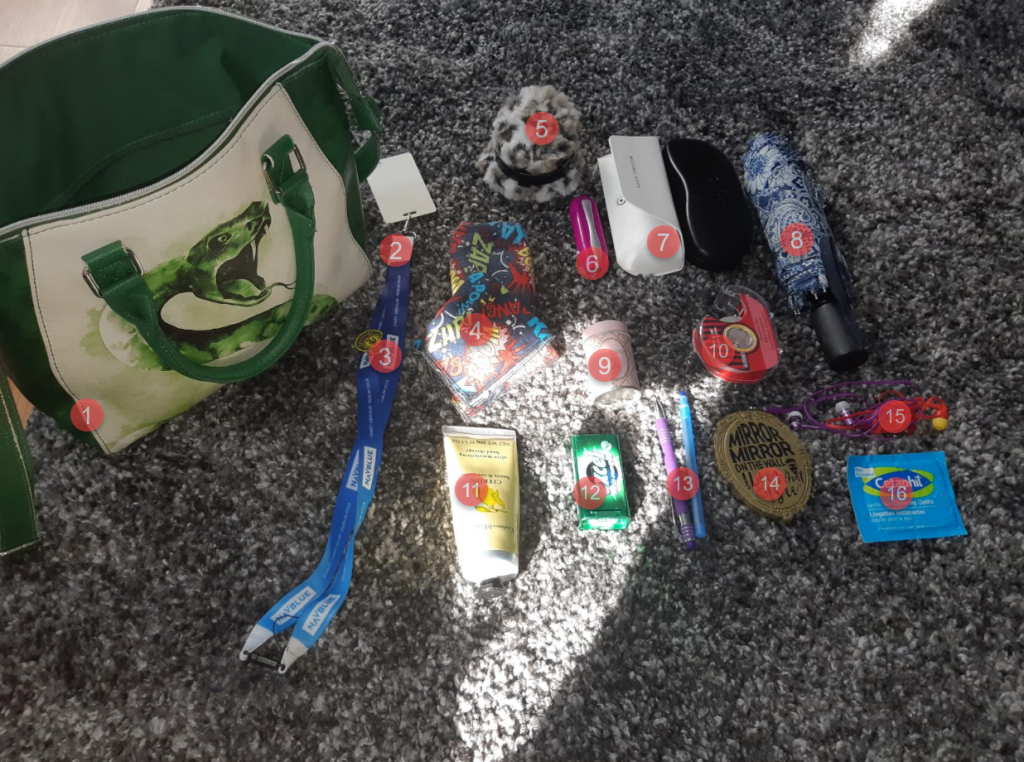
This beautiful graph, created from Stanford’s Palladio tool represents all the songs in the Record Task for “Group 7.” In this graph, we can see the student names EMMA PINDERA (myself), TYLER GRAHAM, and SZU CHUN WANG, the student names are all capitalized, and we can see the nodes connecting the names versus the ones that diverge from the norm.
Firstly, let’s analyze the number of nodes and find the songs that are missing from the Golden Record. There are only 18 nodes out of 27 possible songs on the record. The following songs are not represented in the graph:
- Java, court gamelan, “Kinds of Flowers,” recorded by Robert Brown. 4:43
- Zaire, Pygmy girls’ initiation song, recorded by Colin Turnbull. 0:56
- New Guinea, men’s house song, recorded by Robert MacLennan. 1:20
- Azerbaijan S.S.R., bagpipes, recorded by Radio Moscow. 2:30
- Stravinsky, Rite of Spring, Sacrificial Dance, Columbia Symphony Orchestra, Igor Stravinsky, conductor. 4:35
- Bach, The Well-Tempered Clavier, Book 2, Prelude and Fugue in C, No.1. Glenn Gould, piano. 4:48
- Bulgaria, “Izlel je Delyo Hagdutin,” sung by Valya Balkanska. 4:59
- Holborne, Paueans, Galliards, Almains and Other Short Aeirs, “The Fairie Round,” performed by David Munrow and the Early Music Consort of London. 1:17
- Solomon Islands, panpipes, collected by the Solomon Islands Broadcasting Service. 1:12
In order to look at what songs unite us, as a group, we should also look at the 9 songs that we unanimously avoided. In order to get more insight as to why Tyler and Szu chose the songs they did, I read their blog entries.[1] In my blog entry, I stated that I wanted to focus most on a record that is diverse and represents the world’s many cultures. Whereas I noticed my classmates didn’t focus on a particular vision, rather they chose the songs that meant the most to them, or that they saw were important and valuable. In this case, why are the 9 tracks above unanimously deemed less valuable than the rest? Is it the bagpipes? Or did we unanimously agree that The Well-Tempered Clavier, Book 2, Prelude and Fugue in C, No.1. was Bach’s worst composition? I am being facetious of course, but I think the question must be asked. What are the key factors that make us reject these tracks? The amount of classical songs included in the original record may have played a factor. In addition, trying to ensure that there was representation of music from all the continents before doubling up.
Secondly, let’s look at the songs that unanimously unite us. The following four tracks:
- “Johnny B. Goode,” written and performed by Chuck Berry. 2:38
- Beethoven, Fifth Symphony, First Movement, the Philharmonia Orchestra, Otto Klemperer, conductor. 7:20
- India, raga, “Jaat Kahan Ho,” sung by Surshri Kesar Bai Kerkar. 3:30
- China, ch’in, “Flowing Streams,” performed by Kuan P’ing-hu. 7:37
In my blog post, I stated that I chose Johnny B Goode because of the popularity, message, and the revolution that is Rock and Roll. My classmate Tyler stated on his blog that he too, “love[s] rock and roll,” and references its use within the popular movie Back to the Future. The Beethoven Fifth Symphony was also unanimously chosen among us. I stated that this song makes me think of Fantasia, the musical Disney masterpiece in which it is featured. In comparison, Tyler references its similarity to the melody played during the movie Titanic (or perhaps he is referencing the historic event). I chose Jaat Kahan Ho because I think it is important to keep the capsule as multicultural as possible, and the amount of innovations and culture from India is immeasurable. To paraphrase, my classmate Tyler says he chose the Indian music because of its connection to George Harrison and the Beatles. Finally, Flowering Streams was chosen unanimously. Again, I chose it because of its reference to Chinese culture and my focus on being as multicultural as possible on the record. Tyler references the tones within the song the “microtones” which is distinctly Chinese.
Finally, I want to review the songs that are chosen only by one student in the group. These songs that “divide” us, or show our unique preferences. Out of all of the songs, I only had two that were only chosen by me out of the group, El Cascabel and Night Chant. As previously stated, I chose songs because “I wanted to ensure all voices were heard on this record.”[2] My focus is on diversity and accurately representing the diverse cultures on earth through our music. To compare Szu Chun Wang had 5 songs that she chose, I notice she has a better representation of classical music, so perhaps she believes that these elaborate compositions will be heard better by any alien life forms that hear this record. Tyler, like me, only had two songs that separated himself from the group, Dark was the Night and Morning Star Devil Bird. On his blog post, my interpretation is that he chose Dark was the Night because of the way they sound the “slide guitar” is “devastatingly beautiful” and Morning Star Devil Bird because the Indigenous music is so unique, which “speaks to the diversity of song that exists just on our planet.”[3] Perhaps what I find the most interesting, is that both Tyler and I chose Indigenous songs to be on the record for the reasons of being diverse and to show the diversity of music among cultures, however, we did choose different tracks.
My conclusion on the graph above is that there is far more that unites our choices than divides us. To generalize, we choose the songs to create a diverse selection, while also choosing songs that we recognize and mean something to us. We choose the tracks for their individual beauty and cultural importance. If aliens were to hear these tracks, I am unsure of how they would interpret them. As discussed on the podcast, it is difficult to know whether they will be able to “hear” at all, and if they do, will they hear only the high tones or the low tones? However, due to the wide variety of songs chosen by myself and my classmates, I am sure if the extraterrestrials do have any hearing they will be able to acquire some interpretation out of the record. Although these songs may be important to us, it will not necessarily have the same cultural or historical significance for our “new listeners.”
[1] NOTE: I had some trouble finding Szu Chun Wang’s Golden Record blog entry. I will add an edit to the above if I am able to gain access to her content, so I can add more context to the entry, instead of interpreting my own conclusions.
[2] Pindera, E. (2020). Golden Diversity. Retrieved from TECHNOLOGIES: THE CHANGING SPACES OF READING AND WRITING: https://blogs.ubc.ca/emmapindera/2020/07/03/golden-diversity/
[3] Graham, T. (2020). Golden Record. Retrieved from CECI N’EST PAS UN SITE: https://blogs.ubc.ca/monsieurgraham/golden-record/

 This is my diary, a Harry Potter, Slytherin House journal that I try to write in on a weekly basis. This
This is my diary, a Harry Potter, Slytherin House journal that I try to write in on a weekly basis. This 

